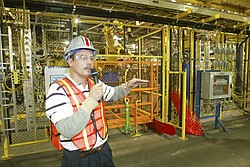METAMORPHOSIS AT LORDSTOWN || GALLERY
GM Lordstown prepares for the Cruze.

GM Lordstown shows off preparations for the Cruze during a June 24, 2009 media tour.
By TOM KRISHER
AP Auto Writer
LORDSTOWN (AP) — As General Motors Corp. undergoes its transformation from big and slow to lean and fast in a New York bankruptcy court, a similar metamorphosis is under way inside the mammoth factory here that will make what arguably is GM’s most important vehicle.
The 5-million-square-foot Lordstown complex will start making the Chevrolet Cruze compact car early next year, and workers assigned to the factory’s $351 million retooling are well aware that they have no margin for error.
“We’ve got to get this right,” says Bob Vizzuso, a toolmaker who on Wednesday was testing machines that link metal parts in the plant’s new body shop. “If it doesn’t look good, at our next station, we’ve got to figure out what’s wrong.”
GM has a lot riding on the Cruze, a sleeker, lighter and better-appointed replacement for the Chevrolet Cobalt, as it tries to enter a market that for years has belonged to the Honda Civic and Toyota Corolla.
To survive after its Chapter 11 reorganization, GM executives and workers know the Cruze, due in showrooms around May 2010, must sell far better than the Cobalt, an outdated model that has fallen far behind the Japanese.
Through May, GM has sold 44,829 Cobalts in the U.S., less than half the 97,505 Civics sold by Honda Motor Co. and the 101,708 Corolla/Matrix models sold by Toyota Motor Corp.
Most industry analysts expect the compact market to grow in coming years, with gasoline prices rising again and government fuel economy standards that will shift the market smaller by requiring the U.S. new vehicle fleet to average 35.5 mpg by 2016.
“It’s going to sell,” says Jim Graham, president of one of two United Auto Workers locals at the Lordstown complex, touting the Cruze’s quality and estimated fuel economy of 40 mpg.
GM also is banking on selling more expensive versions of the Cruze with more options and more profit as people seek the same luxury items in smaller cars as they do in larger ones.
In many ways, the Cruze and its 43-year-old factory are symbols of what GM wants to become.
The car has a far nicer interior than its predecessor, and GM engineers across the globe have tried to make sure that it performs well and is quiet and reliable.
In the factory, backhoes and jackhammers constantly pound on the old concrete floor, digging it up to reconfigure the assembly line, making it more efficient. More than 500 GM workers and 1,100 outside contractors are involved, setting up 800 robots that are either new or reassigned from closed factories.
They’re replacing a 500-foot-long conveyor line with two shorter ones that will keep workers closer to the line and cut the amount of walking they must do to fetch parts. Under the new system, preassembled parts will come down the line with the car bodies for installation. On the Cobalt line, workers constantly have to return to benches for parts, taking away time on the line and cutting productivity.
“They’re not wasting any time walking or moving material around,” said Michele Lambert, manager of the Cruze launch.
Although the plant will be more productive, it still will employ about 2,200 workers, about the same as it has now. The increased productivity will be absorbed into the Cruze line, which has more complex interiors and safety features than the Cobalt. Also, GM is moving assembly of items such as the steering column or instrument panel back into the assembly plant, saving millions of dollars in transportation costs from parts suppliers, plant manager John Donahoe said.
“You’ve eliminated all of the logistical costs of your material movement, which is very expensive,” Lambert said.
When the plant, now closed due to lack of Cobalt and Pontiac G5 sales, comes back on line in August, workers will run the Cobalt down much of the same assembly line that will be used to build the Cruze, practicing its use on the older vehicle.
It’s also an example of the plant’s flexibility. It will be able to build seven different models when the retooling is complete, and will be able to change quickly as the market fluctuates.
But none of that will be worth anything if GM can’t convince people that its cars are competitive in a market that will become crowded with high-quality choices in the coming years.
In addition to the Japanese, Korean automakers Hyundai Motor Co. and Kia Motors Corp. also have high-quality entries. Ford Motor Co. is bringing its well-respected European small cars to the U.S., and Chrysler Group LLC’s alliance with Fiat Group SpA brings the Italian automaker’s technology the market.
“GM built shoddy cars 20 or 30 years ago,” concedes David Green, president of the other Lordstown UAW local. “What that did was give customers a reason to go to foreign products. Now they have a reason to come back and at least try our products.”
 43
43
